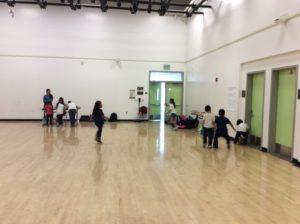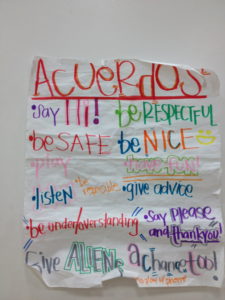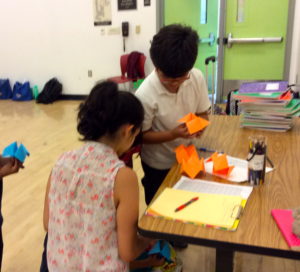 This week I’d like to reflect on a “discussion” of sorts that we held at B-Club two weeks ago, about our “Acuerdos,” or agreements for participation in our club. I’ll share two approaches we took to grounding ourselves in these agreements for the new year. The two approaches illuminate differences between a “teacher-directed” setting and a true community of learners. Along the way I will have a few things to say as well about another study in contrasts: the core values of our club, and our ways of enacting them, and the ones that seem to be reining in this country at this time.
This week I’d like to reflect on a “discussion” of sorts that we held at B-Club two weeks ago, about our “Acuerdos,” or agreements for participation in our club. I’ll share two approaches we took to grounding ourselves in these agreements for the new year. The two approaches illuminate differences between a “teacher-directed” setting and a true community of learners. Along the way I will have a few things to say as well about another study in contrasts: the core values of our club, and our ways of enacting them, and the ones that seem to be reining in this country at this time.
As a teacher, I believe in laying groundwork in any learning community: establishing a set of agreements about how we want to be with each other, and codifying these in some way so that we can hold ourselves and each other accountable. I know it’s important to make this as real as possible, not pro-forma, and not top-down: a genuine buy-in from the group. In my classes, we generally start with a community circle that symbolizes our interconnection: passing a ball of yarn around in spider-web form, with each person holding on to a piece as they voice aloud a commitment of what they will strive to bring to the group.
But as I noted in the first blog of this year, it’s challenging to come together as a group at B-Club, given our numbers, wide age range, and constraining conditions. There is no classroom large enough to hold us, and the MPR just isn’t conducive to large group discussions given its sound quality and the temptations of that big wooden floor.(There are parallels to the nation: it certainly is not an easy task for citizens to come together in any genuine dialogue or “town hall.”)
There is no classroom large enough to hold us, and the MPR just isn’t conducive to large group discussions given its sound quality and the temptations of that big wooden floor.(There are parallels to the nation: it certainly is not an easy task for citizens to come together in any genuine dialogue or “town hall.”)
So this year we decided to divide the group in three. We had formed “buddy groups” consisting of two of the GRUGs and 3-4 of the kids. Our aim was to have buddy groups sit together to have a guided discussion about our agreements.
But a series of things conspired to interfere with the formation our “buddy groups.” And when we entered the classroom space that had been allotted to us for this discussion, we faced long rows of tables facing a white board at the front of the room. So what did we do? We defaulted to the familiar classroom script. I and my team walked to the “front” of the room. The students sat in desks. They self-segregated by age and gender. The GRUGs sat at the back of the room. Everyone faced forward and looked for someone to tell them what to do.
And what did I do? I defaulted into an old familiar teacher-directed classroom script. I assumed the space of authority at the front of the room. I called for the group’s attention. I showed them the poster of Acuerdos  that we had established in the past and asked for volunteers to read the list. I asked for “thumbs up” or “thumbs down” indicating agreement or disagreement with each one. Like good students, everyone gave them all a thumbs up. Of course, this was all pro-forma. Did it really mean they knew or understood or agreed with these agreements?
that we had established in the past and asked for volunteers to read the list. I asked for “thumbs up” or “thumbs down” indicating agreement or disagreement with each one. Like good students, everyone gave them all a thumbs up. Of course, this was all pro-forma. Did it really mean they knew or understood or agreed with these agreements?
As I proceeded with this teacher-directed classroom approach, I found myself distracted by two third graders in the second row. Mical and Keith (pseudonyms) were folding a piece of paper, passing it back and forth, and talking to each other. They weren’t loud or overtly disruptive, but they certainly distracted me, and I found myself triggered. We were talking about our agreements: to be respectful, responsible, and to listen to others. I felt like they weren’t listening to me.
At some level I realized that they may well have been listening as they worked – I myself engage in multi-tasking all the time. I also knew that just because others were quiet and looking at me didn’t mean they were actually listening. I also knew the approach I had taken was, to be honest, BORING. It wasn’t going as I had planned. I knew all these things, but because I had stepped into that teacher-as-singular-authority space, I found it easy to forget, and just to see the boys’ actions in terms of misbehavior.
And of course, I was self conscious. I knew the GRUGS were watching me and that I was serving as a model as they learned to be teachers. I felt trapped by the script I had unwittingly taken up. I knew I had a few choices: I could try to ignore the boys and proceed with the script; I could interrupt the script and assert my power to interrupt the boys’ behavior (by separating them, taking away the paper, or threatening some loss of privilege, such as participation in the club). I knew I didn’t want to do the latter, but I was triggered in that direction more than I’d like to admit.
What I wished for was for the community we were forming to help me out. (The kind of “noticing” and “helping out” that I wrote about in last week’s blog.) I wished for someone to go over and sit with the boys, and coax them into participating in the group discussion – not punishing or threatening them, but finding some way to build our community together. I wished for someone to step up with me and turn this lesson into a poem or a dance or something that would spark the group’s excitement. But I knew the script we were enacting didn’t allow for that. The GRUGs didn’t feel authorized to play such a role. I had assumed the teacher-as-authority position; they were doing their bit as “students as receptacles” – deferring to my authority, with the onus on me to enact that authority. These are roles that are played in school all the time, as teachers “manage” and “control” their students’ behavior rather than creating communities where everyone shares in the responsibility for being the kind of community we wish to be.
Later, when I reflected on what had transpired, I had my first glimmers of insight into different ways of achieving my own goals. Clearly just going over the list of Acuerdos wasn’t a real way of establishing them. It was boring, and it was a set up for resistance from kids like Mikal and Keith.
And just what was it that was fascinating them so much more than the boring adult-led talk?
Mikal and Keith had been teaching each other how to fold paper to create what has been variously called –according to Wikipedia – a “fortune teller,” “cootie catcher,” “chatterbox,” “salt cellar,” or “whirly bird.” (My students added “oracle” and “chismographo” to that list of names.)
They were animated by this activity. There I had been, trying to engage them in the things I wanted to discuss – trying to catch them in like cogs on a wheel – rather than doing what I believe in: looking for where kids light up and following their lead. Finding ways to connect the things I want to teach or impart with the things that kids know and care about. Connecting classrooms to everyday cultural practices, including the practices of children’s culture (cootie catchers, fortune tellers, Pokeman cards, Tachis, and more).
So…What if we made fortune tellers that had the Acuerdos written on them?
So last week that’s what we did. We wrote the acuerdos on the outer flaps, and left space on the inside flaps for kids to write or say what those acuerdos meant for them. We made a bunch and floated them around the club that day. The kids found them, played with them, and spoke the Acuerdos aloud as they had fun and played. (And the magic that I referenced in the first blog started to happen, as we all stepped away from the teacher-directed script and began to build our community of learners.)

Of course, we can’t be sure that Acuerdos made any more sense to the kids in this form than they did in the poster and lecture format. Really, the Acuerdos will have to be lived through our interactions at the club. We may forget and need reminders about how to respect each other, be kind, be safe, and have fun. Perhaps the cootie catchers will help remind us.
Perhaps, as a nation, we could take some lessons from this. What would it mean to really live the values we believe in? What role should leaders play in helping to model and enact and live and support those values? And what about the values themselves? What would it mean to live in a world where respect, kindness, responsibility and having fun were central to everything we did?
Perhaps we should make a whole bunch of cootie catchers to spread B-Club’s values throughout the world. And then hold ourselves collectively responsible for living up to our ideals.
Check out Antero Garcia’s blog on the importance of teaching to counter Trump’s messages about women: http://www.theamericancrawl.com/?p=1602&fb_action_ids=10154207967414865&fb_action_types=news.publishes